Retro gamers have fallen in love with new video game consoles throughout time. Many were masterpieces, but some simply didn’t have the gumption to make it into the ranks of the all-time greats.
Here are six systems that gamers of the Millennium may remember fondly… or have forgotten about, due to their failure.
TurboGrafx-16

Remember the heyday of trading cards? Once upon a time, back in 1987, they collided with the gaming world. The TurboGrafx-16 featured trading card sized games with fiber cartridge piece connections in CD cases, and the Japanese version of the system was the smallest major home game console ever made.
The system featured several hit titles which would be later re-released on other systems. Bonk’s Adventure was later released on the NES as well as on the also failed Wii U. Bomberman 93 would also later come out on the Wii U. The console also showcased one of the first strategy games of its time in the U.S.: Military Madness.
Ultimately the console and cartridge format didn’t make much sense then, and was likely part of its demise. Plus, it had to compete with the Sega Genesis and the Super NES. The original system was discontinued in 1993.
A new TurboGrafix-16, the TurboGrafx-Mini version, without the need of those pesky tiny playing card-sized cartridges, came out in 2020—which sold out when it debuted.
Wii U
Nintendo took a literal U-Turn in the wrong direction when it released the Wii U to the public shortly after its hit console with a stand-alone name. As consumers were waiting for the Xbox One and the Playstation 4 new consoles to come out, Nintendo rushed with its updated version of the Wii.
That rushed update brought a tablet controller with a touchpad screen much like the later popular Switch. Unfortunately, the controllers, called Wii U GamePad, would be expensive to replace (you could buy a controller for the same price as the handheld Nintendo 3DS) and didn’t have the versatility of working on all games, unlike the Switch.
To make matters further confusing, some titles would be released simultaneously on the Wii-U as other Nintendo systems. Super Smash Brothers was released both on the Nintendo 3Ds and the Wii U. The Legend of Zelda: Breath of the Wild was released on both the Switch and the Wii U on the same day. Several of the games popular on the Wii U would outlast the system, as they eventually ported over to the Switch—including MarioKart 8 (called MarioKart Deluxe when ported) and Super Mario 3D World. The system itself lasted five years- from 2012 until being discontinued in 2017.
Sega Dreamcast

While some collectors will rave about this classic system that was before its time, the system did not fare well even then. Several of its games did make top lists, including the first 3D Sonic game Sonic Adventure, Jet Set Radio (currently in discussions for potential revival), SoulCalibur, and House of the Dead 2. A quirky spin of the House of the Dead series, The Typing of the Dead, a coveted and treasured under-the-radar game by Dreamcast fans, would also be a fan favorite for folks coming of age in the early computer era. It used a keyboard peripheral controller, where players typed things to defeat zombies.
Although the incorporated motion controls on the Dreamcast standard controllers were incredibly innovative at the time, they were clunky and confusing. The controllers featured a screen that was supposed to help players monitor their health and other vitals in an accessible way.
The console was also one of the first to have accessible built-in internet capabilities and online multiplayer gaming done via a system ether port. This feature allowed for one of the first MMORPG (Massive Multiplayer Role Playing Games) type games: Phantasy Star Online. Another console and game like this wouldn’t be available until Final Fantasy Online came about with the PlayStation 2.
Between the standard controllers which came with the system, and the tiny disks that often went missing, the system was one of several in Sega’s legacy of systems that would not survive. The system lived only three short years from 1998-2001 before it disappeared. A mini version has been rumored but hasn’t made a cameo just yet.
Neo Geo
This Japanese system of the nineties was possibly the most expensive console of all time… and that may have been a part of its ultimate failure.
The console was more than just a console though. It was part of a full-standing game cabinet straight out of an arcade. The system (originally called the MVS or multi-video system) used cartridges with interchangeable rom software. It featured several fighting game titles including Fatal Fury Special and Samurai Shodown, the first fighting game to incorporate weapons. Aside from its fighting games, the console featured other hit arcade games. The family favorite classic arcade hit Puzzle Bobble (aka Bust-A-Move) also made a cameo.
While thrilling for an arcade gamer, can you imagine having to ask your parents for over 600 bucks (equivalent to over $1300 USD as of 2021) to get a gaming system back in the 90’s? Neither can we. The system lasted seven years from 1990 until 1997.
Phillips CDi
Mario and education-themed games have helped several consoles last the test of time but they did not save the Phillips CDi.
The Phillips CDi, like Sony’s Playstation in 1994, used a compact disk system. Their compact disk interactive system had internet capabilities and a modem. It came with only one controller. Gamers that wanted multiplayer gaming experiences needed to not only buy a second controller, but an adapter for it as well. These elements all became factors that made the system expensive and likely out of price range for its target market.
The system was even more expensive than the Neo Geo — $1000 back in 1990 — and featured several cartoon-graphics styled hits including a Mario puzzle game called Hotel Mario, three Zelda games (Zelda’s Adventure, Link: the Faces of Evil, and Zelda: The Wand of Gamelon), and the classic Dragon’s Lair. It breathed its last gasp of air in 1994.
Sony Ericsson Xperia Play
Did you know that the Playstation had a mobile phone meets gaming handheld device? It wasn’t an app. It was a full “system” called the Sony Ericsson Xperia Play.
The Xperia Play was Playstation’s attempt at a mobile gaming phone… before mobile gaming took off in its own right. The console, powered with Android technology, launched with 50 Playstation One games and featured a phone screen that could be pushed up to reveal a controller underneath it.
Its debut was only available on Verizon phone plans in 2011 and lasted a very short time. This could be due to the exclusive partnership or the name change (it was supposed to be called the Playstation Phone) with the rapid rotation of phone updates and options.
A second version was announced in 2012 that never appeared. This second version was rumored to have appeared in 2020 but also never ultimately came to market.

